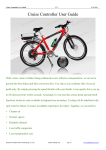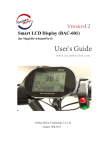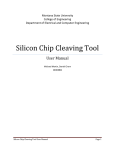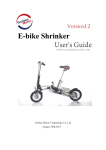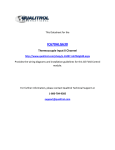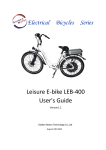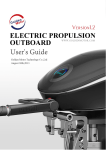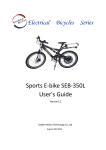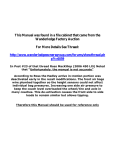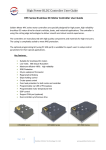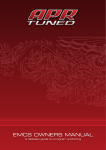Download Installation Guide()
Transcript
Contents Getting started…………………………………………………..…. Page 3 Tool List…………………………………………………………… Page 4 Preparing the Back Wheel……………………………………….... Page 5 Installing the Handle bar Components……………………….……. Page 9 Controller Configuration ………………………………………... Page 12 Installation of the controller and battery…………………………. Page 19 PAS installation…………………………………………...…… Page 23 Power Cord installation…………………………………………..Page 24 (With sliding rack and black controller box) LED Lights Circuit Diagram……………………………………..Page 27 Solution Diagram for Regen Braking……………………………..Page 27 2 Getting started First, open up the box and lay out the contents inside. Check that you have: 1) A motorized wheel 2) A controller set 3) A pair of power brakes 4) Twist throttle and Thumb Throttle Optional items: 1) Battery Pack with adapter 2) Sliding Rack 3) Cruise/Horn Controller Note: Check for any damage on the items. Lay out the items on the floor of your garage and move on to the next pages to start building your eBike. 3 Tools needed for making your eBike: Basic Tools List: P) Q) R) S) At least 6 Zip Ties (For holding wires firmly to your bicycle frame) 3 Allen Wrench with diameters 2.5mm, 3.0mm, 6.0mm Adjustable wrench Philip Screwdriver Optional List: 1) Gear removing tools 2) Washers 3) Wire binders 4) Hammer 4 Preparing the Back Wheel (Includes Gear and Disc Brake) 1) Remove the gear cluster from your old back wheel. Use a Gear-Removing Tool to remove the Gear from your back wheel. Note: The gear removing tool can be found in your local Bike Shops. 2) Installing the Disc Brake Install your Disc Brake onto the Wheel. Note: Please confirm your Disc Brake diameter. (140mm or 160mm) In most cases, 140mm Disc Brakes are for the back wheel whilst 160mm are for the front wheel. 5 Twist the Disc Brake Plate into position. Make sure you insert a Disc Brake Plate-Tube into the axle. Safety Note: The Disc Brake Plate-Tube holds the disc brake in position. It is a very important component in the Disc Brake System. Important Note: Usually, the position of the Disc Brake is to the left of the direction your wheel is travelling. (I.e. The disc brake should be installed on the side where the Motor Wiring protrudes.) Note: Use Washers to adjust the vertical alignment of the disc brake. 6 3) Installing the Gear Cluster Take your preferred Gear Cluster and twist it onto the other side of the Motor. Note: Golden Motor Wheels supports most of 3- to 6-speed gear clusters. 4) Installing the Tires First confirm the direction of the thread pattern of your tire. Next place one edge of the outer tire into the rim bedding. 7 Turn the wheel around and fit the inner tubing’s gas valve into the opening of the wheel’s rim. Stuff the rest of the inner tubing in between the rim and the outer tubing and you’re done assembling the wheel! Important Note: Please choose an inner tube with a longer valve as Golden Motor rims are double walled. The rims are double walled to be able to withstand the powerful torque from the motor. 8 Place the wheel axles into the mount in your bike frame. Push down on the bike frame to make sure that the wheel axle is locked tightly into the frame. Tighten the bolts; make sure it is very tight. This is for safety reasons and this is a very crucial step to build a good eBike. The torque of the motor is very powerful, which is why you must make sure the bolts are tight enough to handle it. In order for you to remember this important step, we’ve even made a nice little poem, read it below and we hope that this will help you remember this every time you build an eBike. Important GoldenMotor Poem: Tighten the bolts with all your might, Make sure the wheel is secured and tight. The entire back wheel is not very light, Double check both the bolts on each side. If anything falls off while you ride It won’t be a very pleasant sight. -Yao Yuan 9 Installing the Handle Bars Components IMPORTANT! : Make sure your handle bar diameter is 22mm 1) Installing the Cruise Control and Horn Switch (2.5mm Allen Wrench) Slot the switch into the handle bar. Note: You can slot it into the side you feel comfortable with pressing the buttons. The red button activates the cruise control and the green button activates the horn. However, you can also use these buttons for other purposes you wish for. Place your hand on the handle bar and find the ideal position of the switch where your thumb is able to press the two buttons comfortably. Then use the 2.5mm Allen Wrench to tighten it. Safety Note: Make sure that when your hand is on the handle bar, your thumb is able to reach both buttons. 2A) Installing the Thumb Throttle Pick a type of speed throttle you wish to install. A- Thumb throttle B- Twist throttle Note: If you already have a gear shift, then we suggest you use the thumb throttle. 10 Take the mini-tripod and place it in the thumb throttle as shown. Note: This tripod comes useful if you are installing the thumb throttle on the right side of the steering bar. The tripod prevents the edge of the movable ring from getting stuck when it comes into contact with the exterior handle bars. Slot the thumb throttle into either side of the steering bar that you feel comfortable with. Place your hand on the bar and find the position where your thumb feels most comfortable pressing down on the throttle. Use the 3.0mm Allen Wrench and tighten the bolt beneath the throttle. Safety Note: Make sure that you secure the throttle onto the bar tightly. Note: The red button on the throttle is a switch for you to connect to a lamp if you have one on your bike or you can use it for other purposes. 11 2B) Installing the Twist Throttle (Right Side) Slot the Twist throttle into the right side of the bar and get a feel of twisting the throttle. When you feel comfortable with the position, use the 3.0mm Allen Wrench and secure it into place. 3) Installing the Hand Brakes Slot your hand brakes into both sides of the steering bar. Place your hand on the bar and find the position you feel most comfortable with pressing the brake and then use a 5.0mm Allen Wrench and secure it into place. Safety Note: Make sure the brake is secured tightly as a loose brake may lead to an accident. Finally, push the plastic handle bars into the metal steering bar tightly and make sure it is pushed in all the way. Note: This Hand Brake cuts off power supply to the motor and activates the mechanical brake simultaneously You are now done with the handle bars! 12 Controller: Your controller looks something like this. Notice that the controller has 5 single connectors labeled: A, B, C, D and E and 4 pin-connectors labeled: W, X, Y and Z. Usually the controller comes with wires already connected to the connectors. If otherwise, the following will tell you more information about the wires. The following picture shows how a completely connected controller should look like: 13 Information of your Controller: 1) Four Single wires: Black, Green, Light Blue and Yellow. 2) One 12-hole pin connector with the thicker Red wire connected to a Single Red Wire labeled with a Positive “+” Sign. 3) One 5-hole pin connector. 4) One 2-hole dual red wire pin connector. Connecting Wires * Photos show connection before installing, but you should make these connections after installing the components 1) The Wheel and Motor: Single out the Yellow, Light Blue, Green Single wires and the 5-hole Pin connector of your Controller. Find the 3-hole Pin connector, Green, Blue and Yellow Single Wires of your Motor. Next, take the motor’s wires and connect them like so: Safety note: Make sure you hear a “Click” sound when you connect the pin connectors. 14 2) The Horn: Take the Horn and connect it to the 2-hole pin connector. 3) The Battery: Take your controller and plug in the Black Single Wire and the Red Single Wire. The outer ends of these 2 wires should have been labeled with positive or negative signs. Take the Battery Pack’s wires and connect them accordingly. Safety note: Make sure that you have connected the wires correctly before turning on the power. If unsure, use a Voltmeter to confirm the poles are correct. It is IMPORTANT to connect them correctly as a short circuit may occur. Disclaimer: GoldenMotor will not be responsible for any damage caused to the controller if a short circuit occurs. 15 4) The Throttle: Take the throttle wire and single out the 3-hole pin connector. Take the 3-hole pin connector (Blue, Black, Red) from the controller area Z and plug them together. Safety Note: Make sure you hear a “Click” sound when you connect them. If not your motor would not work. 16 5) The Brakes: Find the 2-pin connector (Black and White wires) from area Z and plug it into the Brake wire. Note: This brake does not control the disc brakes on your wheel, it only cuts out the power supply to the motor. You would have to connect this brake to your disc brake manually. By squeezing the brake, the controller enters regenerative braking mode for smooth stopping. 6) Cruise Speed Control: Find the 2-hole pin connector (Beige and Black wires) and plug it into your Cruise Control system. 17 7) PAS (Pedal Assistance System ): For customers who opted for PAS, plug your PAS 2-hole pin connector into area Y Note: Power ON the pedelec by pressing the Cruise Control Button twice. Power it OFF by cutting off the power supply to the controller. The Pedelec function is made this way so that only intentional use is allowed for safety reasons. Wiring Information: For more detailed information, please visit this website link: http://goldenmotor.com/e-Bike-DIY/Cruise%20Controller%20Wiring%20Diagram.pdf How to Enable/Disable these Functions/Features? 1. Cruise speed control: Pressing the cruise control button will make your eBike maintain the speed you are currently at. Squeezing the brakes or pressing the cruise control button again will disable it. 2. Motor hall-sensor malfunctions: When the controller detects a motor hall-sensor failure, it will beep twice before automatically entering into sensor-independent control mode. Twist/press the throttle to run the motor and pedal your bike for a push start if the motor does not operate. (This malfunction seldom happens in a state of sensor-independent control status) 3. Throttle malfunctions: When the throttle fails to function correctly, the controller will beep three times. In this situation, press and hold the cruise control button to drive your bike at half the maximum speed. The controller will automatically return to its original status when the problem is resolved. 18 4. Power-brake lever malfunction: If the power-brakes level malfunctions ( i.e. disconnected from the controller), twist/press the throttle repeatedly for at least four times. The controller will then beep four times if this malfunction is detected. Similarly, press and hold the cruise control button to drive your bike at half the maximum speed. The controller will automatically return to its original status when the problem is resolved. 5. Unknown malfunctions: If your eBike fails to move and the cause is unknown or if your battery is low, you can force your eBike to work. While squeezing the power-brakes, press the cruise control button five times and if you hear the honk from your horn, press and hold the cruise control button again and you can drive your bike at half speed. You will need to turn off the battery power to reset the controller back to normal mode after the problem is resolved. 6. Anti-theft alarm setting: Cut off power supply to motor (called soft-switch, but controller is still powered on) and take out the battery key, within 10 seconds press and hold the cruise control button until you hear a beep sound, then release the cruise control button. The vehicle is now protected from theft and the motor is electronically locked. Any movement or vibration of vehicle will trigger the siren for 30 seconds, and the motorized wheel will resist any pedaling movement. 7. 1+1 Pedal Assist Mode: Release the throttle to its neutral position during riding, press cruise speed controller button twice, listen a beep sound, the system enters into pedelec (PAS) mode. Cut off power supply to the controller to reset this system. 8. Motor phase Calibrating (Use it only if your motor is not from GoldenMotor): The controller can work brushless motors with different phase angles other than defaulted 120 degree. Below are procedures to allow the controller to match the motor phases: z z z z z z Cut-off power to controller and motor Grip and hold power brake lever, turn throttle to maximum speed position, press and hold the cruise control button, turn on the power switch (using battery key) Connect battery power to the system, release throttle, release brake lever, release cruise control button. Listen for two beep sounds, then turn the motor wheel forward and reverse once. When you hear a beep sound, motor phase calibrating is successful. If it fails, swap any two of the three motor phase wires, and repeat the above steps. 19 Installation of the Controller and Battery 1) Controller Box Place the controller into the box and secure it with tape or screws. Note: Controller boxes will be on sale in June 2009 on the GM website. Safety Note: Make sure you secure the components in the box properly. 2) Sliding Rack Fix your Sliding rack onto your bicycle. However, do not tighten the screws as we need to put in the controller box later. Note: These frames are purchasable at the Golden Motor website under the category eBike D.I.Y. Note: Make sure your box can fit onto the sliding rack. 20 3) Wire binding Bind the wires using Zip Ties in a way such that it does not restrict the movement of the steering bar. Find ways to lock all the wires onto your bicycle frame such that they are not very visible. Also secure the brake threads to your front and back brakes accordingly. Note: As a suggestion, after you bind your wires, rotate your bike handles to see if the movement is smooth. 4) Connecting the wires to your controller Refer to the guide on the Controller and connect your wires to the controller accordingly. 21 Use Zip Ties or anything else you prefer to secure the controller box onto the sliding frame. Note: You can place the controller box wherever you feel like as long as the wires are long enough to connect to it. 5) Battery placement Slide the battery pack onto the sliding rack with the battery’s handle bar facing backwards. Plug the cable in but do not twist the key.Proceed to the final checklist before testing your bike. Safety note: Make sure the battery is turned off before you even plug in the power cable. 22 6) Finishing the fight Checklist: (Turn off the battery) 1) 2) 3) 4) 5) 6) 7) 8) 9) Wheel is secured in place. Back wheel is vertically aligned with front wheel. Wheel has no loose parts. All components on the handle bar have been secured tightly. You are comfortable with the throttle, brakes, etc. The handle bar is able to rotate freely. The mechanical brakes work properly. The battery cannot slide off without unlocking it. Check that the battery poles are connected correctly. If there are no problems, then turn on the battery, lift up the rear end so that the rear wheel is not touching the floor, start the throttle to test the wheel. Congratulations! You have completed your own custom made Electric Bicycle Important Note: While using regenerative braking, DO NOT turn off the battery. 23 PAS Installation PAS (Pedal Assistance System), also known as pedelec system, is a compulsory component of an electric vehicle in European countries. The system controls the amount of electricity supplied to the motor proportional to the angular velocity of the pedal. (i.e. the faster you pedal, the faster the motor turns.) After removing the the pedal crank arm, place the receiver ring into the axle and secure it in position using washers or superglue. Place the outer magnetic ring next to the inner ring. Make sure they do not have any contact in between using washers. Screw back the pedal into place, connect the PAS wire with the controller and you are ready to ride legally in Europe. 24 Power cable installation guide (If you purchased our sliding rack and controller box) To make sure our power cord is connected securely to the battery, we have made extra measures to ensure this, however the procedure is also made more difficult. Hence follow this guide to beat this tricky installation part. You should have: 1)The sliding rack 2)The Black Controller box 3)Black connector 4)Plastic connector-protector 5)Power cord The point is to get the wires through one of these two holes. Therefore we sent you items 3,4 and 5 separately as item 5 must be thin enough to go through this hole. First, slide the power cable through the controller box’s hole as shown on the right. 25 Next, take one of the two power cables and bend it as shown. Slide in the unbent cable into the protector. After the wire has been pushed through, push the bent wire in as well, this is because the neck of the protector is not big enough to fit both at the same time. When both power cords go through, push the protector all the way back. 26 Look closely at the ends of the power cord, it looks like a talon. Keep in mind that this is designed to be a talon, like a giant-ass eagle that wants to claw and grip onto the connector. Watch out for the “+/-” signs on the connector, make sure Red goes into + and black goes into - . Push all the way in until you hear a click sound. Make sure the “Nails of the Talon” has reached the end and clipped onto the metal plate. If this is done correctly, it is nearly impossible to pull out the power cord without tools. Slide back the protector and Voila! You’re done, grab a beer to congratulate yourself. (Or if you are a minor, get some Pepsi instead) 27 28 Resolved Case: Burnt out Controller by regenerative braking. Important! When you turn off the battery and continue riding by pedaling, using the regenerative braking may burn out your controller. The current generated from the regenerative braking flows into the battery under normal circumstances. However if you turn off the battery, the current gets trapped inside the controller and if the current is too large, it will burn the controller. Hence, GoldenMotor engineers will place a diode inside as shown in the circuit diagram above as of July 6th 2009. Users, who ride our bike in terrains that contain steep slopes, please ensure that your battery is always turned on. If you have experience in engineering, please install a diode of rating 100V 20A inside the battery pack according to the diagram above. When the battery/switch is turned off, the current generated by the regenerative braking will still flow into the positive terminal, charging the battery. However the electrical energy from inside the battery itself cannot flow out due to the diode. This basically solves most issues for riders who live in mountainous regions with hills or slopes steeper than 10degrees. For riders who live in places with flat terrains, this is not a necessity. For your own safety and for the controller’s safety, please ensure that your battery is always turned on unless you have installed this diode. GoldenMotor batteries will all be equipped with this diode from July 6th 2009 onwards. Hence, for users who are using batteries from other sellers or have bought GoldenMotor batteries before the 6th of July, please take note of this issue. Many thanks to Gregory McIntire, a GoldenMotor customer whom brought up, brainstormed and resolved this issue. 29 Written and editied by: GM:Yao Yuan Tom Update contributors: Duane Smeckert Gregory McIntire 30































